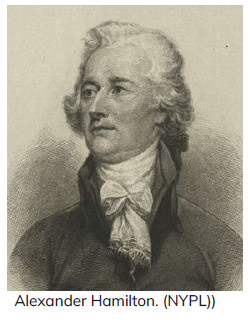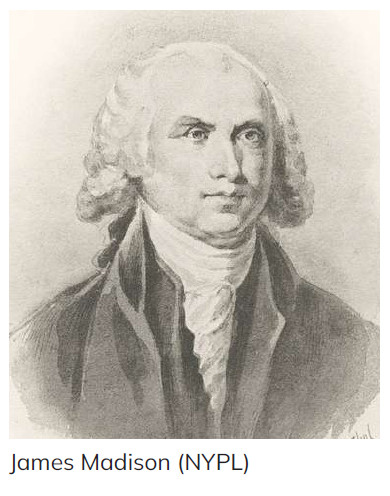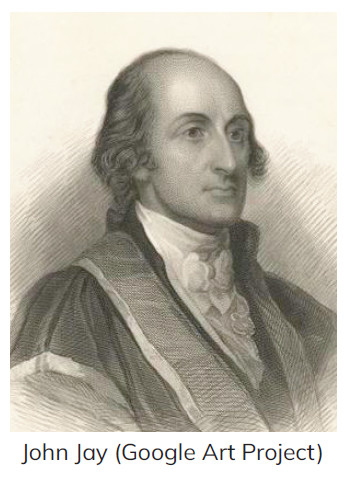Download Lesson |
Before the Constitution could become “the supreme law of the land,” it had to be ratified or approved by at least nine of the thirteen states. The delegates to the Philadelphia Convention signed the Constitution on September 17, 1787, and they knew ratification would not be easy. Many people were bitterly opposed to the proposed new system of government. A public debate soon erupted in each of the states over whether the new Constitution should be accepted. More important, it was a crucial debate on the future of the United States.
 Nowhere was the furor over the proposed Constitution more intense than in New York. Within days after it was signed, New York newspapers criticized the Constitution. Many commentators charged that the Constitution diminished the rights Americans had won in the Revolution. Alexander Hamilton was fearful that the cause for the Constitution might be lost in his home state. He devised a plan to write a series of letters or essays rebutting the critics.
Nowhere was the furor over the proposed Constitution more intense than in New York. Within days after it was signed, New York newspapers criticized the Constitution. Many commentators charged that the Constitution diminished the rights Americans had won in the Revolution. Alexander Hamilton was fearful that the cause for the Constitution might be lost in his home state. He devised a plan to write a series of letters or essays rebutting the critics.
It is not surprising that Hamilton, a brilliant lawyer, came forward at this moment to defend the new Constitution. At Philadelphia, he was the only New Yorker to have signed the Constitution. The other New York delegates were convinced that the rights of the people were being abandoned. They angrily left the Convention.
Hamilton himself was very much in favor of strengthening the central government. Hamilton would have called for a president to be elected for life. He also wanted the president to have the power to appoint state governors. But Hamilton soon backed away from these ideas, and decided that the Constitution, as written, was the best one possible.
 Hamilton published his first essay in the New York Independent Journal on October 27, 1787. He signed the articles with the Roman name “Publius.” (The use of pseudonyms by writers on public affairs was a common practice.) Hamilton soon recruited two others, James Madison and John Jay, to contribute essays to the series. They also used the pseudonym “Publius.”
Hamilton published his first essay in the New York Independent Journal on October 27, 1787. He signed the articles with the Roman name “Publius.” (The use of pseudonyms by writers on public affairs was a common practice.) Hamilton soon recruited two others, James Madison and John Jay, to contribute essays to the series. They also used the pseudonym “Publius.”
James Madison — sometimes called the Father of the Constitution — had played a major role during the Philadelphia Convention. As a delegate from Virginia, he participated actively in the debates. He also kept detailed notes of the proceedings and drafted much of the Constitution.
Unlike Hamilton and Madison, John Jay of New York had not been a delegate to the Constitutional Convention. A judge and diplomat, he
Between October 1787 and August 1788, “Publius” wrote 85 essays in several New York newspapers. Hamilton wrote over 60 percent of these essays and helped with the writing of others. Madison probably wrote about a third of them with Jay composing the rest.
 The essays had an immediate impact on the ratification debate in New York and in the other states. The demand for reprints was so great that one New York newspaper publisher printed the essays together in two volumes. These were entitled The Federalist, A Collection of Essays, written in favor of the New Constitution, By a Citizen of New York. By this time the identity of “Publius,” never a well-kept secret, was pretty well known.
The essays had an immediate impact on the ratification debate in New York and in the other states. The demand for reprints was so great that one New York newspaper publisher printed the essays together in two volumes. These were entitled The Federalist, A Collection of Essays, written in favor of the New Constitution, By a Citizen of New York. By this time the identity of “Publius,” never a well-kept secret, was pretty well known.
The Federalist, also called The Federalist Papers, has served two different purposes in American history. In its time, the 85 essays succeeded by helping to persuade doubtful New Yorkers to ratify the Constitution. Today, The Federalist Papers helps us to more clearly understand what the writers of the Constitution had in mind when they drafted that amazing document more than 200 years ago.
The complete text of The Federalist Papers
Questions
- What was the purpose of The Federalist Papers?
- How do The Federalist Papers differ from other founding documents?
- Were The Federalist Papers successful? Why or why not?


